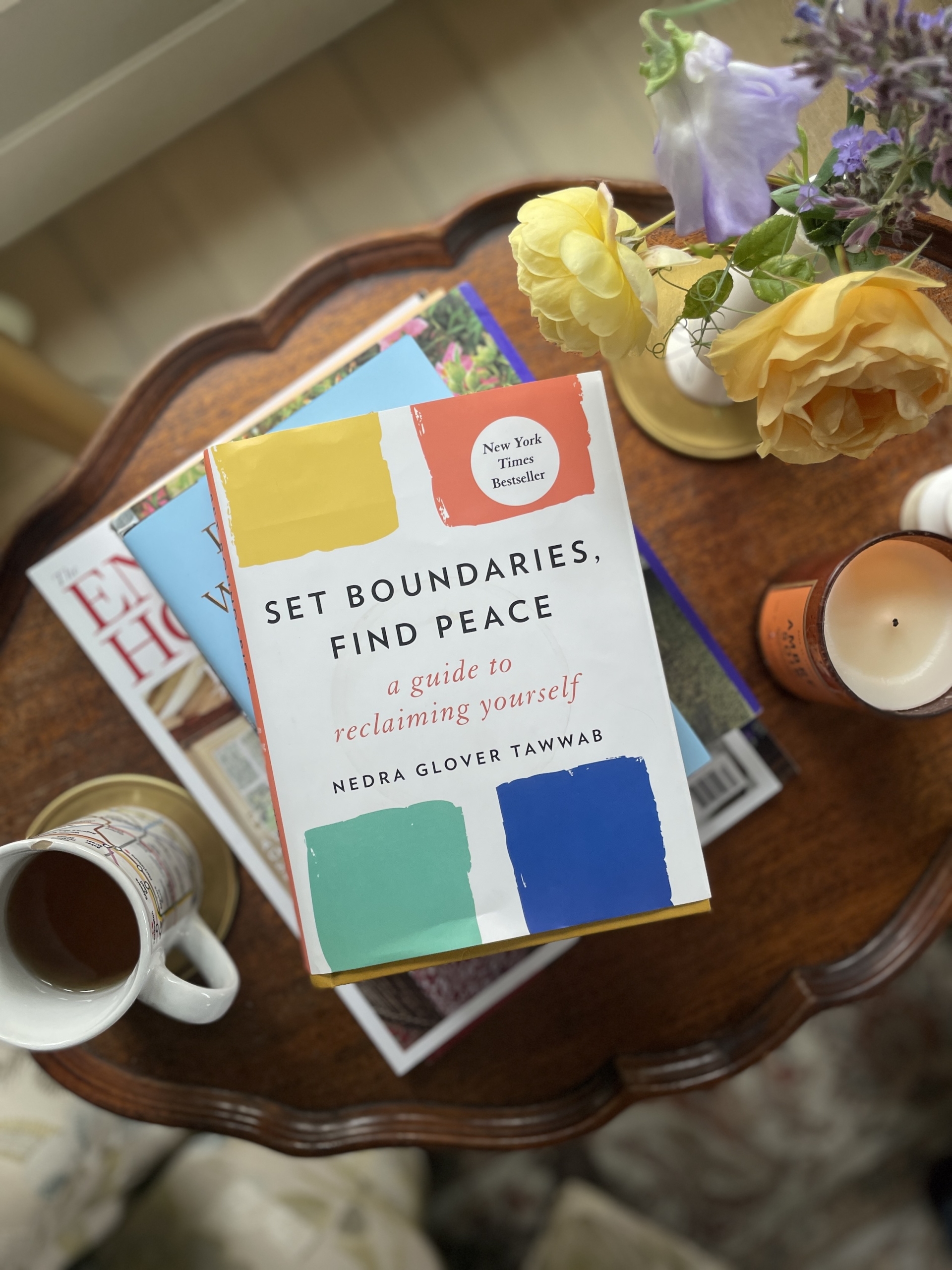Become a Member for as little as $4/mo and enjoy unlimited reading of TSLL blog.
“Creating healthy boundaries is how you ensure that you’re happy and well in your relationships and in life.” —Nedra Glover Tawwab, Set Boundaries, Find Peace: A Guide to Reclaiming Yourself
To have boundaries that are respected is to give your life and your days peace of mind.
Just as a sovereign state provides the foundation for its citizens to thrive instead of merely surviving due to the absence of worrying if what they need to live well might not be theirs tomorrow, so too do the boundaries we assert, communicate and actively uphold. But as is alluded to, we must engage consciously, intentionally and consistently.
Licensed therapist for more than 14 years, Nedra Glover Tawwab wrote a book, a highly successful and praised both by readers and critics book, titled Set Boundaries, Find Peace: A Guide to Reclaiming Yourself, that is exactly what her book provides – a guide. A guide sharing the tools, but also the reasons to motivate readers to welcome boundaries into their daily lives, whether with their friendships, work, children, parents, romantic partnership and even regarding our use of social media and technology. Boundaries, healthy boundaries, as she explains the non-healthy boundaries and why they are destructive and deteriorate the quality of our lives, are an essential piece of our everyday life if we wish to live a life of contentment. And her book is a hands-on step-by-step guide teaching you how and which boundaries you need.
Upon reading this book, I immediately knew I had found a valuable resource, one to not only utilize now for different aspects of my life, but no doubt in the future either when I want to be reminded or discover what I need to do, how to communicate and validate my decisions to honor my needs. As well, just as importantly, is to understand and honor what others needs as well and to not take their boundary setting personally.
In today’s episode/post I would like to share with you how setting the right boundaries contributes, and exclusively contributes an essential ingredient that elevates the quality of our lives, thereby deepening our true contentment experienced in our everydays. If what is shared today speaks to you, I highly recommend picking up a copy of the book where you will find the specific examples of what to do/say, what not to do/say in very specific, as well as different situations.
First, different types of boundaries exist and different ways of setting boundaries exist, all but one in each are constructive, healthy and effective in the short and long haul for building healthy relationships with others and honoring ourselves. I want to begin quickly by distinguishing these key differences that Nedra teaches in her book.
Types of boundaries:
- Porous — weak or poorly expressed and are unintentionally harmful that aim to create closeness, but the type of closeness is unhealthy (examples: oversharing, inability to say no, dependency on feedback from others, fear of being rejected, and others, all shared in the book)
- Rigid — involve building walls to keep others out as a way to keep yourself safe, but this extreme distance is unhealthy (examples: never sharing, building walls, enforcing strict rules that are unconditional and never change based on context and growth, avoiding vulnerability, and others, all shared in the book)
- GOAL: Healthy — “your past doesn’t show up in your present interactions. [Healthy boundaries] require awareness of your emotional, mental and physical capacities combined with clear communication.”
—source, Set Boundaries, Find Peace (2021)
Different Approaches to Setting Boundaries:
- Passive — denying your needs, ignoring them to allow others to be comfortable (examples: ignoring things that are triggers for you, allowing people to do or say things with which you disagree and others, all shared in the book)
- Aggressive — attacking another person with harsh, pushy or demanding words and behaviors, instead of stating what we want. (examples: demeaning others to make your point, yelling, name-calling, cursing, using the past to shame, being loud and wrong, using cynical humor to ridicule, and others, all shared in the book)
- Passive-Aggressive —Tawwab shares that this is the #1 way we communicate our feelings and needs, but it is not effective. “When we resist directly setting boundaries to avoid confrontations, we are hoping the other person will figure out what they are doing is wrong and self-correct . . . being indirect is counterproductive because our needs go unmet. This only makes us more frustrated and overwhelmed with our interactions.” (examples: clearly being upset but refusing to admit it, being moody for no reason, gossiping about things you could fix, but have no intention of addressing, verbal attacks unrelated to the current situation and other, all shared in the book)
- Manipulation — saying or doing things to hopefully cause the other person to feel guilty and do what we want (examples: gaslighting, telling a story that is intended to evoke pity, withholding affection to get you to feel bad and/or change your behavior, and others, all shared in the book)
- GOAL: Assertive — when you clearly and directly state your needs which involves communicating your feelings openly and without attacking others. (examples: saying no to anything you don’t want to do, responding in the moment, talking directly to the person you have issues with instead of talking to a third party, making your expectations clear up front – no assumptions they will figure it out and others, all shared in the book)
—source, Set Boundaries, Find Peace (2021)
Successful Communication of a Boundary:
- Be clear, being as straightforward as possible, minding your tone, avoid using complicated language or jargon the listener may not know.
- Directly state your need or request, or say no. You are not asking. You are commanding. In other words, what you will be doing, or what you can do
- Don’t explain why your boundary is being set. Your needing it is enough and it also opens the door for the recipient to try to manipulate you to waffle and back down.
- Take action. In other words, be consistent in upholding your boundaries if they are violated after you clearly communicated them.
- Restate as necessary.
With the fundamentals of boundaries in mind, let’s dive right in to the power of setting boundaries in our lives.
Embracing a self-care practice as a necessity
“The root of self-care is setting boundaries.”
In TSLL’s free monthly newsletter sent out for October, I shared how self-care as taught by Nedra, “isn’t selfish. Saying ‘no’ to helping is an act of self-care. Paying attention to your needs, is self-care.” By exercising the tool of self-awareness, when we assess in ourselves that we are overwhelmed, burn-out, have no regular time to ourselves, avoiding phone calls and/or interactions, or feeling resentful, we then know we need to rebuild (or build) our healthy boundaries in the necessary arenas of our lives.
Our overall well-being depends on self-awareness, taking action to care for ourselves well, so that we can live with peace of mind that when we notice something crosses a line for us, we will speak up, and we will not passively or aggressively let it infect our lives. Self-knowledge is crucial, and something we have talked about since the first years of posting on TSLL. Know yourself, and then you have the guide for how to best care for yourself.
~explore more TSLL posts/episodes on the topic of Self-Care
Your healthy boundaries communicate to others how to treat you
“A boundary is a cue to others about how to treat you.”
Nedra explains that boundaries can be explicit (directly stating them verbally) or implicit (no television outlets or technology portals in the bedroom). Feeling comfortable defining your boundaries with others is often determined by how you were raised. If you saw healthy boundaries that enabled you to both relax and be yourself, but asked of you to honor and be aware of others and their property, then defining your boundaries as an adult will likely be easier; however, if the contrary is true, setting boundaries will feel ‘unnatural’, but there is nothing unnatural about honoring what you need. And just as it is important for us to communicate and have healthy boundaries, we should be aware of the boundaries others set and respectfully honor what they are commanding is needed for them should we want to engage or spend time with them.
Discover which relationships to invest your time, heart and energy
“Boundaries are the cure to most relationship problems. But both parties have to participate and respect the boundaries of either side.”
As we begin the journey of knowing what we need, and then learning the tools of how to communicate the boundaries to honor our needs, we will begin to discover truths about the current relationships we have in our lives. After communicating our boundaries, the healthy response by the person we are speaking to is acceptance. Nedra shares, such a response is “a sign of a functional, mutual relationship”. However, “when people respond in an unhealthy way, it’s typically a sign that you needed limits a long time ago and that you need to reevaluate the relationship to assess whether your needs are being met satisfactorily.”
While for some people who will stay in our lives and who genuinely love us, it is important to know that acclimating to the new boundary may take time, but how you communicate your boundary (see the list above) and how you follow through demonstrating your seriousness, will communicate to them the necessity and your sincerity. Others who will stay in your life may respond rather quickly and may even thank you for letting them know where your boundary is. Often we fear the worse, when the actual response is quite benign and un-noteworthy.
Physical and Mental Health Improve
Whether when setting boundaries with other people or with ourselves – how we spend money, how we use technology, how we care for our bodies, setting boundaries that prioritize our well-being improves all areas of our life.
Prior to setting healthy boundaries, you may have noticed that your “brain has difficulty shutting down, constantly replaying thoughts, worrying about having enough time” and thus our sleep is affected and our stress-levels continue to ramp up. Tawwab shares that common presentations of boundary issues are poor self-care, resentment, feelings of being overwhelmed and avoidance.
A core part of why your brain won’t turn off is because you don’t know what is around the corner, and since you don’t have firm boundaries that honor your needs, you don’t trust yourself to say no, and thus you are dreading tomorrow, dreading the next work project, relationship conflict, etc., etc., etc.
When we have confidence in our ability to set healthy boundaries with others, it is important to make sure we set healthy boundaries with ourselves.
“The ability to say no to yourself is a gift.”
When we can respond to our needs and wants, but not react to our impulses and urges, we are caring for ourselves well. This is setting a boundary. When we have priorities in our lives, the response to quell the urges when they arise is easier because we have a motivation to honor the boundary. Each of our decisions, small or large – squeezing in one more appointment into an already busy day, saying yes to the extra project to try and impress the boss even at the expense of your sleep – affect the quality of our lives, but at the core when we say yes to the two examples just mentioned, we are dishonoring our boundaries.
Other examples of setting boundaries for yourself include the treatment you allow from others, the people you allow in your life and yes, your thoughts. I share this last item with you because yet again, we see how mindfulness comes into play to deepen our true contentment. In this case when we have control of our thoughts, an ability that is strengthened through meditation and other mindfulness practices, we begin to strengthen our self-awareness, we begin to gain clarity and thus decision making becomes evermore easier. Not easy, mind you, because setting boundaries never involves a guilt-free scenario Nedra reminds, but easier. “There is no such thing as guilt-free boundaries. Guilt is part of this process.” And this next insight she shared spoke volumes of truth, “Guilt typically happens as a result of thinking that what we are doing is ‘bad’. It comes from your programming about telling people what you need or want.” And guess what? Guilt is merely a feeling. I say merely because all feelings are temporary, fleeting, and the guilt you feel, so long as the boundary you are setting is honoring what you need, will not stay around for long. It has been my experience that as Tawwab teaches, the guilt, when I examine it, arises from my life journey not reflecting what others understand, nor want for their life, which I then tell myself, their life is not my journey and I have to live my life as they have the opportunity to live theirs.
Once you begin to honor your true self, speak to yourself lovingly and welcome into your life loving connections where you both have set healthy boundaries, then the mind has the ability to calm down, and with your strengthening of the mind, you gain more space to think clearly and well when you do so, which helps you make better decisions, honor your personal boundaries for food, exercise and sleep, and that all contributes to your overall physical and mental health.
The life we imagine would be a joy to live is within our possibility to nurture into our everyday reality. Boundary setting, healthy boundary setting is a crucial skill to learn, but it is a skill. We were not born knowing how to set boundaries. Unconsciously we were taught, either healthy or unhealthy examples, but it is with Nedra Glover Tawwab’s book that we have a hands-on, step-by-step resource to refer to as we choose to not only honor our true selves, but be cognizant and respectful of others’ boundaries so that we can build the relationships we desire, live the life we may have only once dreamed about and reduce the stress in our everydays so we can fully savor each day we have the good fortune to experience.
~Explore Set Boundaries, Find Peace: A guide to reclaiming yourself by Nedra Glover Tawwab
~follow the author on Instagram, @nedratawwab

SIMILAR POSTS/EPISODES YOU MIGHT ENJOY:
episode #126, A Powerful Couple: Boundaries & Vulnerability

episode #307, How to Step into your Fullest True Self — The Way of Integrity as taught by Martha Beck

Petit Plaisir
~The Seven Spiritual Laws of Success: A pocketbook guide to fulfilling your dreams by Deepak Chopra

~The Simple Sophisticate, episode #343
~Subscribe to The Simple Sophisticate: iTunes | Stitcher | iHeartRadio | YouTube | Spotify | Amazon Music
[podcast src=”https://html5-player.libsyn.com/embed/episode/id/24875976/height/90/theme/custom/thumbnail/yes/direction/forward/render-playlist/no/custom-color/d0d4b9/” width=”100%” scrolling=”no” class=”podcast-class” frameborder=”0″ placement=”bottom” primary_content_url=”http://dts.podtrac.com/redirect.mp3/traffic.libsyn.com/thesimplesophisticate/343Boundaries.mp3″ libsyn_item_id=”24875976″ height=”90″ theme=”custom” custom_color=”d0d4b9″ player_use_thumbnail=”use_thumbnail” use_download_link=”use_download_link” download_link_text=”Download the episode” /]




Thank you for this post and the book recommendation (ordered the book & workbook). I had started to set some boundaries for myself back in May, but they were not as constructive or as clear as they could have been and even perhaps a little (unintentionally) hurtful. With clearer direction, I hope to refine this process. Take care!
Thank you, Shannon. It was very helpful for me to listen to the podcast in the context of the conversation at A Cuppa Moments, and it made me even more interested in reading the book fully. Added to my reading list, of course.
It has been a bit of an uncharacteristic Saturday for me, but it gave me the opportunity to catch up on my TSLL reading/ participation, which is a very nice thing to do, together with a cup of tea. Or several. 🙂
This looks like an interesting read. I’m sure that I will be able to incorporate some of these practices into my life. Thank you for the recommendation.
My pleasure. ? It is a book I highly recommend and am glad to have found it, even if more than a year after its release ? Thank you for stopping by and saying hello.
I purchased the book and read more than half of it last night. As I read, I recognized some of my weaknesses, and I now have some awareness of boundaries that I can put in place. The limit testing is especially difficult. Luckily I don’t remember being put in this position lately. I wish there were more specific responses sited in the book when someone puts you in that tough position.
Listened to this podcast twice, love the practical definitions of boundaries. Will definitely be incorporating the techniques into my life. Thanks for sharing Shannon.
Thank you for listening twice! ☺️ I am so glad I came across her book. Validating and clear in how to move forward healthily and for stronger more supportive and truly loving connections of all types.